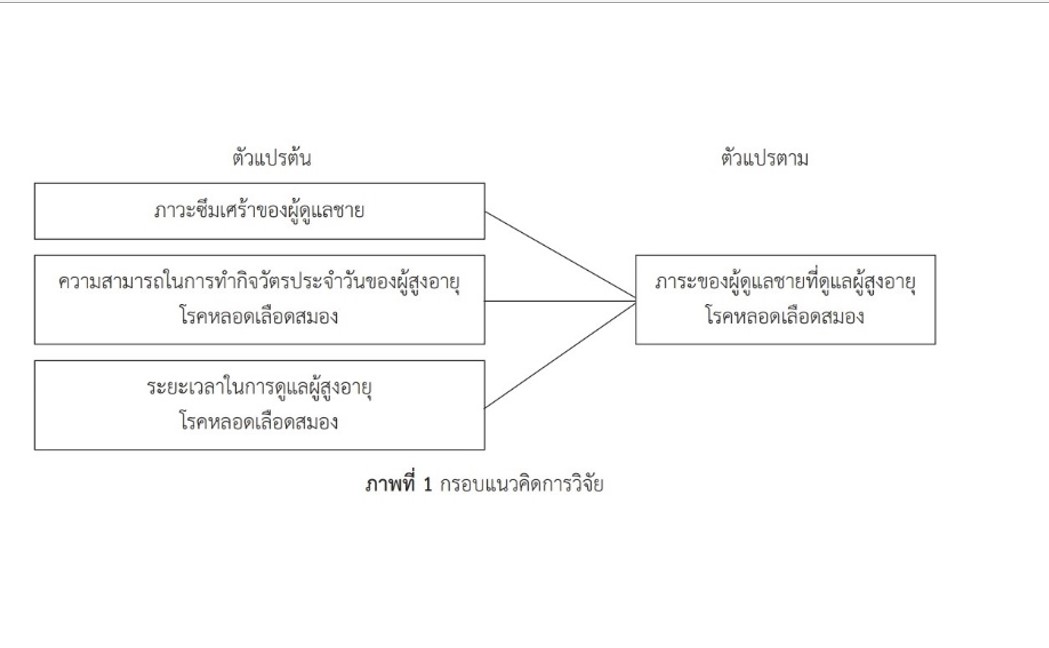ปัจจัยที่มีความสัมพันธ์กับภาระของผู้ดูแลชายที่ดูแลผู้สูงอายุโรคหลอดเลือดสมอง จังหวัดสมุทรสาคร
คำสำคัญ:
ผู้ดูแลชาย, ผู้สูงอายุโรคหลอดเลือดสมอง, ภาระผู้ดูแลบทคัดย่อ
การวิจัยนี้มีวัตถุประสงค์เพื่อศึกษาภาระของผู้ดูแลชายที่ดูแลผู้สูงอายุโรคหลอดเลือดสมองและปัจจัยที่มีความสัมพันธ์กับภาระของผู้ดูแลชายที่ดูแลผู้สูงอายุโรคหลอดเลือดสมอง กลุ่มตัวอย่าง คือ ผู้ดูแลชายที่ดูแลผู้สูงอายุโรคหลอดเลือดสมองและพาผู้สูงอายุมาติดตามการรักษาที่โรงพยาบาลบ้านแพ้ว (องค์การมหาชน) จังหวัดสมุทรสาคร จำนวน 97 ราย ซึ่งได้มาโดยการสุ่มตัวอย่างแบบง่าย เครื่องมือที่ใช้ในการวิจัยประกอบด้วย แบบสอบถามข้อมูลส่วนบุคคล แบบประเมินความสามารถในการทำกิจวัตรประจำวันของผู้สูงอายุ แบบประเมินภาวะซึมเศร้า และแบบวัดภาระของผู้ดูแลผู้ป่วยเรื้อรัง ซึ่งมีค่าความเที่ยงเท่ากับ .81 และ .81 ตามลำดับ เก็บรวบรวมข้อมูลระหว่างเดือนพฤษภาคม ถึงเดือนสิงหาคม พ.ศ. 2564 วิเคราะห์ข้อมูลโดยใช้สถิติเชิงพรรณนา และค่าสัมประสิทธิ์สหสัมพันธ์ของเพียร์สัน
ผลการวิจัย พบว่า กลุ่มตัวอย่างผู้ดูแลชายที่ดูแลผู้สูงอายุโรคหลอดเลือดสมอง มีคะแนนเฉลี่ยภาระการดูแลอยู่ในระดับน้อย (M = 29.64, SD = 12.20) ภาวะซึมเศร้าของผู้ดูแลชาย และระยะเวลาในการดูแลผู้สูงอายุโรคหลอดเลือดสมองมีความสัมพันธ์ทางบวกกับภาระของผู้ดูแลชายที่ดูแลผู้สูงอายุโรคหลอดเลือดสมองอย่างมีนัยสำคัญทางสถิติ (r = .626, p < .001; r = .378, p < .001 ตามลำดับ) ส่วนความสามารถในการทำกิจวัตรประจำวันของผู้สูงอายุโรคหลอดเลือดสมองมีความสัมพันธ์ทางลบกับภาระของผู้ดูแลชายที่ดูแลผู้สูงอายุโรคหลอดเลือดสมองอย่างมีนัยสำคัญทางสถิติ (r = -.603; p < .001) ผลการศึกษาครั้งนี้ เสนอแนะว่า พยาบาลและบุคลากรทางสุขภาพ ควรนำผลการวิจัยไปใช้เป็นแนวทางในการพัฒนากิจกรรมในการส่งเสริมความสามารถในการทำกิจวัตรประจำวันของผู้สูงอายุโรคหลอดเลือดสมอง เพื่อลดภาระของผู้ดูแล และลดระยะเวลาในการดูแลผู้สูงอายุโรคหลอดเลือดสมอง
เอกสารอ้างอิง
Akelma, K. F, Ergil, J., Ozkan, D., Arık, E., Akkuş, I. B., & Aydın, B. D. (2020). The effect of preoperative warming on perioperative hypothermia in transurethral prostatectomies. Gulhane Med J, 62(1), 114-120.
Cao, J., Sheng, X., Ding, Y., Zhang, L., & Lu, X. (2019). Effect of warm bladder irrigation fluid for benign prostatic hyperplasia patients on perioperative hypothermia, blood loss and shiver: A meta-analysis. Asian Journal of Urology, 6(2), 183-191.
Cobb, B., Cho, Y., Hilton, G., Ting, V., & Carvalho, B. (2016). Active warming utilizing combined IV fluid and forced-air warming decreases hypothermia and improves maternal comfort during cesarean delivery: A randomized control trial. Anesth Analg, 122(5), 1490-1497. doi: 10.1213/ANE.0000000000001181
Faul, F., Erdfelder, E., Buchner, A., Lang, A. G. (2009). Statistical power analyses using G*Power 3.1: Tests for correlation and regression analyses. Behav Res Methods, 41(4), 1149-1160. doi: 10.3758/BRM.41.4.1149
Jareonrattanadaechakul, N., Sukhupragarn, W., & Nusupa, W. (2016). Comparison of effectiveness for intravenous warming devices at different flow rates in Maharaj Nakorn Chiang Mai hospital. Thai Journal of Anesthesiology, 42(3), 167-77. (in Thai)
Jo, Y. Y., Chang, Y. J., Kim, Y. B., Lee, S., & Kwak, H. J. (2015). Effect of preoperative forced-air warming on hypothermia in elderly patients undergoing transurethral resection of the prostate. Urol J, 12(5), 2366-2370.
John, M., Crook, D., Dasari, K., Eljelani, F., El-Haboby, A., & Harper, C. M. (2016). Comparison of resistive heating and forced-air warming to prevent inadvertent perioperative hypothermia. British Journal of Anaesthesia, 116(2), 249-254.
Lopez, B. M. (2018). Postanaesthetic shivering - from pathophysiology to prevention. Romanian. Journal of Anaesthesia and Intensive Care, 25(1), 73-81.
Madrid, E., Urrútia, G., Roqué i Figuls, M., Pardo-Hernandez, H., Campos, J. M., Paniagua, P., Maestre, L., & Alonso-Coello, P. (2018). Active body surface warming systems for preventing complications caused by inadvertent perioperative hypothermia in adults. Retrieved from https://www.ncbi.nlm.nih.gov/pmc/articles/PMC8687605/pdf/CD009016.pdf
Moawad, H. EI. S., & Elawdy, M. M. (2015). Efficacy of intrathecal dexmedetomidine in the prevention of shivering in patients undergoing transurethral prostatectomy: A randomized controlled trial. Egyptian Journal of Anaesthesia, 31, 181-187.
Plicharoenpon, P. (2015). Randomized prospective comparison of forced air warming using custom-made blankets from disposable surgical gown versus commercial blankets in patients undergoing intra-abdominal surgery: Non-inferiority trial. Region 4-5 Medical Journal, 34(4), 281-96. (in Thai)
Prajannual, C., Satitkanmanee, T., Treeputtarat, S., Teerapongpakdde, S., Nonlaopol, D. & Tincheelong, V. (2013). Factors affecting hypothermia during surgery in standard prophylaxis adult patients: Study case-control. Thai Journal of Anesthesiology, 39(3), 183-191. (in Thai)
Punyasawat, S. (2015). The incidence and factors related to shivering of patients after surgery in Nong Khai hospital in 2015. Nakhon Phanom Hospital Journal, 3(1), 10-16. (in Thai)
Thabo Crown Prince Hospital, Information Center. (2020). Registration statistics and anesthetic complication Thabo Crown Prince hospital. Retrieved from the HOS-XP reporting system.
Xu, H., Xu, G., Ren, C., Liu, L., & Wei, L. (2019). Effect of forced-air warming system in prevention of postoperative hypothermia in elderly patients: A prospective controlled trial. Medicine (Baltimore), 98(22), 1-6. doi: 10.1097/MD.0000000000015895
Zhang, R., Chen, X., & Xiao, Y. (2018). The effects of a forced-air warming system plus an electric blanket for elderly patients undergoing transurethral resection of the prostate: A randomized controlled trial. Medicine (Baltimore), 97(45), 1-7. doi: 10.1097/MD.0000000000013119

ดาวน์โหลด
เผยแพร่แล้ว
รูปแบบการอ้างอิง
ฉบับ
ประเภทบทความ
สัญญาอนุญาต

อนุญาตภายใต้เงื่อนไข Creative Commons Attribution-NonCommercial-NoDerivatives 4.0 International License.




